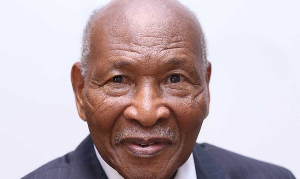Opinions of Friday, 25 August 2023
Columnist: Kenneth Krieger
Mastering the art of negotiation: Strategies for business success
Many of us realize too late that we've missed out on getting a better deal because we failed to negotiate effectively. This six-part series aims to change that by shedding light on the art of negotiation, especially in the business world. Imagine the impact on your bottom line if you could improve your negotiation outcomes by just 5% on all future deals, be it salary, purchases,
sales, or contracts.
Introduction to negotiation: Understanding the importance
The stark reality of negotiation's importance hit me hard in my first job post-graduation. A fellow graduate, let's call him Mike, joined the same department at the same time as I did. Over lunch one day, he casually mentioned his salary, and to my surprise, it was significantly higher than mine. Despite my longer hours and superior results, Mike was earning more. When I asked him how he secured such a lucrative offer, he simply replied, "I negotiated, of course".
I vowed to myself that day, that I was going to become a negotiation expert.
Negotiation is a process by which people resolve differences. It's a delicate balance of achieving the best possible outcome for your position while ensuring fairness, mutual benefit, and relationship maintenance.
It's not about winning or losing, but about creating win-win situations. This was the secret to Mike's success.
As a wise friend once said, "The art of negotiation, my friend, is about understanding, communicating, and finding a solution that benefits everyone".
So, let's embark on this journey to become better negotiators and ensure we never leave anything on the table again. Stay tuned for the next part of this series, where we'll delve deeper into the fundamental principles of
negotiation.
In business, negotiation skills can mean the difference between a successful deal and a missed opportunity. Whether it’s salary negotiations, client contracts, or corporate mergers, effective communication can lead to improved outcomes and stronger relationships.
In this series, we will explore the principles of networking, the preparation and use of strategies, and how to apply these strategies to real-world situations. We will also discuss the skills needed for successful communication and how to make it work.
Types of negotiation: Distributive vs. integrative
Negotiation can take many forms, but two common ones are distributive and integrative negotiations. Distributive negotiation is often referred to as a 'zero-sum' or 'win-lose' situation, where any benefit I make is at your expense. One way to look at this is to imagine that two people are sharing 100 Ghana Cedis. For every Cedi assigned to one, the other loses a Cedi.
Integrated negotiation or 'win-win' negotiation involves a scenario where the parties arrive at mutually beneficial solutions, They cooperate to find a mutually beneficial outcome. In general, you stand to gain more when you approach the conversation from an integrative mind rather than a distributive one. Allow me to illustrate this with a short story.
Two chefs (let’s call them Chef A, and Chef B) reach into the fridge to pick up an orange for a recipe each is working on. They find that there’s only one orange left. Conventional wisdom tells us that they should split the orange into equal halves.
This is a distributive mindset. However, if they each take their time to ask the other, what he/she needs the orange for, they will be surprised to find out the following: Chef A needs the juice for an orange Bundt cake while Chef B wants to use the zest (i.e. the peeled skin) of the orange for an orange pound cake. Had they not taken time to understand what the other chef needed in the orange, they
would have each walked away with exactly 50% of what they wanted from the orange.
From this example, integrative negotiation has given them 100% of what they want instead of 50% from distributive negotiation.
The role of perception and culture: Age and cultural norms
Our perceptions and biases can significantly impact the negotiation process. For instance, if we perceive the other party as untrustworthy, we might be less open to their ideas or less willing to share information. It's crucial to be aware of these biases and not let them cloud our judgment.
An example of this difference in perception that we see play out in our business environment is one where there is a vast age difference. Where the young/people see(s) the older one as conservative, strict, and unbending, the older party views the younger as brash, disrespectful, and careless. The two need to see the strength in the other and use that to forge a strong agreement. Whereas the young know the rules, the old know all the exceptions.
In addition, the young must take care in respecting all cultural norms that are expected whenever he/she is interacting with older people. Behaviors like shaking hands with the right hand and using “please” and “thank you” go a long way in removing any preconceived notion that the young may be acting disrespectfully.
In 2012, Facebook acquired Instagram for $1 billion, a deal that was significant not just for its size but also for the age difference between the key negotiators. Facebook's CEO, Mark Zuckerberg, was 27 years old at the time, while Instagram's CEO, Kevin Systrom, was just 28.
However, their young age also led to perceptions of risk and uncertainty among their stakeholders. Investors, employees, and users of both platforms were concerned about the ability of these young CEOs to manage such a significant deal and the integration of the two companies.
Zuckerberg and Systrom had to manage these perceptions throughout the negotiation process.
They had to demonstrate their maturity and capability to lead the deal and the subsequent integration of Instagram into Facebook. They also had to convince their stakeholders of the strategic value of the acquisition.
In the end, they were able to successfully negotiate the deal, and the acquisition has since been hailed as one of the most successful in the tech industry.
The importance of trust: Building confidence in deals
Trust is a vital component of successful negotiation. When parties trust each other, they're more likely to share information, consider each other's viewpoints, and work collaboratively towards a solution. Building trust can involve demonstrating reliability, showing empathy, and maintaining open and honest communication.
In 2016, Microsoft announced its intention to acquire LinkedIn for $26.2 billion, marking one of the largest tech deals at the time. The negotiation process was swift, taking only a few weeks, and was characterized by a high level of trust between the two parties.
Microsoft CEO Satya Nadella and LinkedIn CEO Jeff Weiner had a shared vision for the potential of the integration, which facilitated the negotiation process. Both leaders trusted each other's intentions and commitment to the deal, which allowed them to navigate the complex details efficiently.
The trust between the two CEOs was crucial in ensuring the success of the deal. It allowed them to overcome potential roadblocks and move quickly toward an agreement. The acquisition was completed successfully, and LinkedIn has since continued to operate independently under Microsoft's ownership, as was promised during the negotiations.
This case study highlights the importance of trust in negotiations, particularly in high-stakes corporate deals where the future of entire companies and their employees are at stake.
Non-verbal communication: The unspoken language of negotiation
In the world of business, negotiation is an art form, a delicate dance that requires a balance of assertiveness and empathy, strategy and spontaneity. While the words we use in negotiation are undoubtedly important, non-verbal communication often speaks louder.
It's an underappreciated aspect of negotiation that can significantly influence the outcome of a deal.
Non-verbal communication includes a range of behaviors and cues, such as facial expressions, body posture, gestures, eye contact, and tone of voice. These signals can convey confidence, interest, understanding, or discomfort, often more accurately than words.
Consider the power of eye contact. Maintaining steady eye contact during a negotiation communicates confidence and sincerity. It shows that you're engaged in the conversation and that you respect the other party. On the other hand, avoiding eye contact can signal discomfort or a lack of confidence.
Similarly, body language plays a crucial role. An open posture, leaning in slightly, can indicate interest and openness to the other party's ideas. In contrast, crossed arms or leaning back might suggest defensiveness or disinterest.
Even the tone of voice can significantly impact the message's reception. A calm, steady tone can convey confidence and control, while a high-pitched, fast-paced voice might indicate nervousness or uncertainty.
However, non-verbal communication is not a one-size-fits-all approach. Cultural norms can influence the interpretation of these cues. For instance, in some cultures, maintaining direct eye contact might be seen as aggressive rather than confident. Therefore, it's essential to be aware of these cultural nuances in international business negotiations.
In conclusion, mastering non-verbal communication can give negotiators an edge. It allows them to convey their intentions and emotions more effectively, build rapport, and read the other party's signals. So, the next time you enter a negotiation, remember it's not just about what you say, but also how you say it.
Common mistakes in negotiation: Pitfalls to avoid
Navigating the complex world of negotiation can often feel like walking through a minefield. Even the most seasoned negotiators can fall prey to common missteps that can undermine their efforts and lead to suboptimal outcomes.
One of the most frequent errors is the lack of preparation. Going into a negotiation without a clear understanding of your own goals, the needs of the other party, and the broader context is akin to setting off on a journey without a map. Thorough research, careful analysis, and strategic planning are the cornerstones of successful negotiation.
Another common pitfall is focusing too much on positions (what we want) rather than interests (why we want it). By digging deeper to understand the underlying interests, negotiators can uncover new possibilities for mutual benefit and create solutions that leave all parties feeling satisfied.
The story recounted earlier about the two chefs in a restaurant’s kitchen illustrates this point perfectly.
Negotiators often make the mistake of neglecting the relationship aspect of negotiation. It's not just about clinching the deal; it's also about fostering and maintaining relationships. Treating the other party with respect, demonstrating empathy, and striving for a fair outcome can help build trust and lay the groundwork for future negotiations.
Emotions can run high during negotiations, and it's all too easy to let these feelings cloud our judgment. However, allowing emotions to dictate decisions can lead to poor outcomes. It's crucial to manage emotions effectively, stay calm under pressure, and maintain a clear, rational perspective.
Unilateral concessions are another common mistake. While compromise is an integral part of negotiation, making concessions without getting something in return can set a dangerous precedent. It's essential to ensure that any concessions are reciprocated by the other party.
Many negotiators fall into the trap of viewing negotiation as a zero-sum game, where one party's gain is automatically the other party's loss. This is known as the 'fixed pie' fallacy. In reality, by exploring creative solutions, it's often possible to expand the pie and create win-win outcomes.
Finally, ignoring the Best Alternative To a Negotiated Agreement, or BATNA (we’ll talk more about this in part 2), can lead to accepting unfavorable terms. Knowing your BATNA gives you the power to walk away from a bad deal and can significantly strengthen your negotiating position.
Conclusion: The art of win-win and continuous learning
In conclusion, being aware of these common negotiation pitfalls and actively working to avoid them can significantly enhance your negotiation outcomes. Remember, negotiation is a skill that can be honed with practice, self-awareness, and continuous learning.
In this first part of the series, we've explored the art of negotiation, its types, the role of perception, trust, non-verbal communication, and the common mistakes made during the process.
We've also delved into the impact of culture and age on negotiation, providing real-life examples and case studies to illustrate these concepts.
We've learned that negotiation is not just about winning or losing, but about creating win-win situations that benefit all parties involved.
It's about understanding, communicating, and finding solutions that cater to everyone's needs. It's a delicate balance of assertiveness and empathy,
strategy and spontaneity.
We've also discovered that our perceptions and biases can significantly impact the negotiation process. Trust is a vital component of successful negotiation, and non-verbal communication often speaks louder than words.
Moreover, we've realized that even the most seasoned negotiators can fall prey to common missteps that can undermine their efforts and lead to suboptimal outcomes.
In the realm of business, these insights are invaluable. Whether it's negotiating a salary, a client contract, or a company merger, effective negotiation can lead to improved outcomes and stronger relationships. It can mean the difference between a successful deal and a missed opportunity.
As we conclude this series, remember that negotiation is a skill that can be honed with practice, self-awareness, and continuous learning. So, the next time you enter a negotiation, remember, that it's not just about what you say, but also how you say it. And most importantly, “leave nothing on the table”.
In the high-stakes world of business negotiations, the principle of leaving
nothing on the table signifies the meticulous pursuit of all available opportunities, resources, and concessions to their maximum potential. This approach demands that negotiators explore every conceivable advantage, ensuring that no potential benefits remain unclaimed or overlooked.
The essence of this strategy is to craft negotiations so astutely that the best
the possible deal is secured, with no opportunities left untapped or compromises left unexplored.
It's a doctrine that embodies the relentless pursuit of excellence in the negotiation arena.













